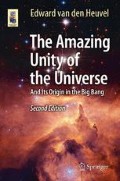Abstract
Where did the protons, neutrons and electrons in the hot Big Bang come from? Gamow and his collaborators had, without giving an explanation for it, assumed that everything started with neutrons and a very large amount of radiation energy. In 1953 Alpher, Herman and Follin had, just as the later workers mentioned in the last chapter, assumed a mixture was present of neutrons, protons, electrons, neutrinos and anti-neutrinos, plus very much heat radiation. But where did these particles come from? The answer is: they originated from the photons of this heat radiation of the Big Bang.
Almost everything originates from almost nothing
Henri- Frédéric Amiel (1821–1881), Swiss philosopher
Access this chapter
Tax calculation will be finalised at checkout
Purchases are for personal use only
Notes
- 1.
Primary cosmic rays are atomic nuclei with extremely high energies which, coming from outer space, continuously bombard the -->Earth’s atmosphere. These primary particles are mostly protons (nuclei of hydrogen atoms), but also some heavier nuclei are present, as well as electrons and positrons. The nuclei can have energies up to 1020 eV, ten million times higher than the energies that the largest particle accelerators on Earth can achieve. The origin of these primary cosmic rays is only partly known. A part of them originates in supernova explosions, another part is accelerated near the supermassive black holes in the nuclei of galaxies. Low-energy cosmic rays can also originate in eruptions on the sun, so-called solar flares, and their analogues on other solar-like stars. When primary cosmic ray particles collide with the nuclei of oxygen or nitrogen atoms in the Earth’s atmosphere -->, their energy is converted into thousands of new elementary particles, the so-called secondary cosmic rays. These are electrons and positrons, and also various types of mesons, such as pions and muons -->, which later also decay into electrons and positrons. The avalanche of these secondary particles produced by one primary particle at several tens of kilometres height in the atmosphere, is called and air shower. It can on the Earth’s surface be hundreds of meters wide. It was in such an air shower that the first positron was discovered.
- 2.
Planck suffered many disasters in his personal life. His two daughters both died during childbirth, one of his sons was killed in the First World War, and the second one was executed in 1944 by the Nazis for his participation in the Stauffenberg assault on Hitler.
- 3.
See Steven Weinberg: Dreams --> --> of a Final Theory, Hutchinson Radius, London 1993.
Author information
Authors and Affiliations
Rights and permissions
Copyright information
© 2016 Springer International Publishing Switzerland
About this chapter
Cite this chapter
van den Heuvel, E. (2016). The Origin of the Matter in the Universe. In: The Amazing Unity of the Universe. Astronomers' Universe. Springer, Cham. https://doi.org/10.1007/978-3-319-23543-1_10
Download citation
DOI: https://doi.org/10.1007/978-3-319-23543-1_10
Published:
Publisher Name: Springer, Cham
Print ISBN: 978-3-319-23542-4
Online ISBN: 978-3-319-23543-1
eBook Packages: Physics and AstronomyPhysics and Astronomy (R0)

